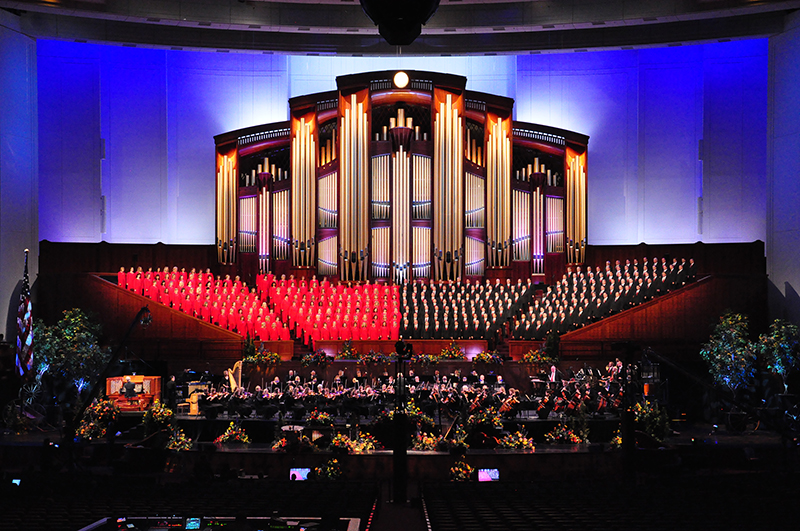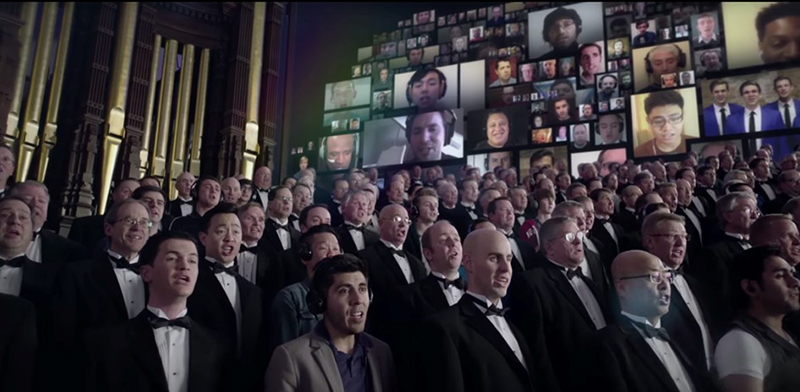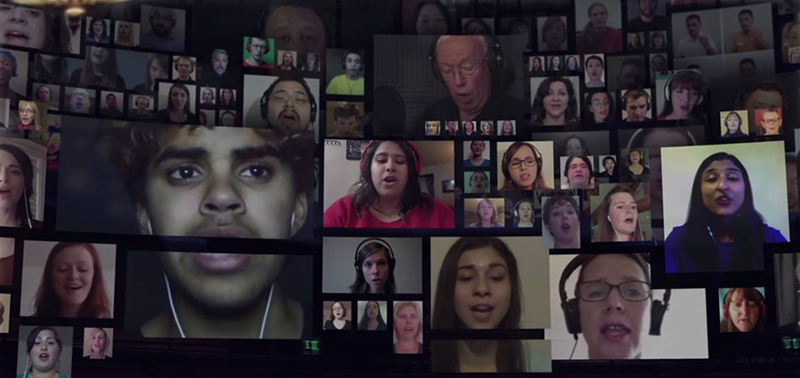
Mormon Tabernacle Choir and Orchestra on Temple Square in the historic Tabernacle in Salt Lake City. Photo courtesy of Mormon Tabernacle Choir
(RNS) It’s a staple of the Christmas season, along with trees and carols. But the Mormon Tabernacle Choir is making a daring pitch with Handel’s “Messiah.”
This Easter season, the big choir is not only singing the beloved choral work, it is sharing it in outsized ways.
Earlier this month, it released a two-CD recording of the “Messiah” featuring a new edition of the work by Mack Wilberg, director of the 360-voice choir.
A week later, it posted a YouTube video of a “Virtual Hallelujah Chorus” featuring many of the 2,500 submissions of people across the globe singing the soprano, alto, tenor or bass parts of the chorus that has long brought people to their feet. And it expects to have two full-house performances on Maundy Thursday and Good Friday; the latter will be live-streamed and available on demand until April 4.

The Mormon Tabernacle Choir and Orchestra on Temple Square was joined by a “Virtual Hallelujah Chorus” in the historic Tabernacle in Salt Lake City for a YouTube video released in March 2016. Photo courtesy of Mormon Tabernacle Choir
Though the original “Messiah” performance likely featured no more than 60 performers in the chorus and orchestra, experts say the piece has come to be performed by far larger numbers of musicians, including the Mormon Tabernacle Choir.
“What they’re doing maybe is the largest, but in fact is part of a long tradition of singing ‘Messiah’ with large forces,” said Teresa M. Neff, musicologist of Boston’s Handel and Haydn Society, which sings with the same number of musicians used in Handel’s day.
Video courtesy of Mormon.org via YouTube
RELATED STORY: Global hymn singfest to focus on Christian persecution
The “Messiah” is sung much more at Christmastime than at Easter, said Liza Beth, spokeswoman for Chorus America, a Washington-based advocacy group.
But Wilberg said the Easter date is quite fitting since Handel premiered his piece on April 13, 1742, in Dublin.
“Most of the piece is not really Christmas-related,” he pointed out. “For instance, the beginning of the second part starts with the chorus ‘Behold the Lamb of God who taketh away the sins of the world.’”
The new adaptation focuses on the editions of “Messiah” by Mozart and Ebenezer Prout but maintains Handel’s baroque style.
“In the back of my mind was always, ‘What would Handel have done with this if he were writing for a choir of 360 voices and a 70-piece orchestra?’” Wilberg said.
After combing through the notes of the 53-movement work, he changed the length of some of them — for instance, turning a quarter note into an eighth note, meaning it would be sung for half as long as previously.
“I didn’t change Handel’s rhythm at all, but I changed the length of the notes from time to time — actually quite a bit — so that the choir was singing exactly the length of the note that I wanted and also reflected what would have been the baroque style,” he said.

Recording of Virtual Choir with the Mormon Tabernacle Choir and Orchestra at the historic Tabernacle on Temple Square in March 2016. Photo courtesy of Mormon Tabernacle Choir
Then the choir management jumped two and a half centuries ahead to the digital age, soliciting submissions for the Virtual Hallelujah Chorus. The finished video features, via green-screen technology, a wall of hundreds of images of people singing with the chorus in the Mormon Tabernacle. Extras in street clothes, and outfitted with headphones and earphones, are sprinkled among the traditional choristers in their white gowns and tuxedos.
“Vocal ability wasn’t a criteria,” said Scott Barrick, general manager of the choir, of the digitally enhanced “Hallelujah” that included submissions from singer Donny Osmond and Utah Gov. Gary Herbert.
“This is the most ecumenical experience that the choir has experienced in terms of being able to have additional singers singing with them.”
This rush of Easter-related activity is occurring within a religious group that celebrates Easter but does not usually mark the days leading up to it with the services and liturgies that Protestants and Catholics observe annually.
RELATED STORY: Pastor pens verses on gun violence sung to the tune of church hymns
The almost 10,000 free tickets to the Mormon Tabernacle Choir performances — live in the Salt Lake Tabernacle and simulcast in two nearby venues — were distributed in 10 minutes, said Barrick.
Some of the additional performance locations will link the choruses with charity, just as Handel did at performances of the piece. Proceeds from the Dublin premiere went to help the sick, prisoners and orphans, and he later performed “Messiah” at a children’s hospital in London.
In Vermont on Holy Saturday, a small arts center in St. Johnsbury will live-stream the performance to benefit an interfaith social mission that feeds the hungry.
On the other side of the country on Good Friday, Butte, Mont., Mormons have rented a middle school auditorium for the live stream and are encouraging hundreds of community members to bring food and financial donations for the Butte Rescue Mission.
“That’s a great portrayal of how it was in the past,” said D.J. Savage, an office manager for the mission who will be collecting goods and singing the bass part of the Messiah. “It’s almost like bringing it back to how it was almost 300 years ago.”
(Adelle M. Banks is production editor and a national reporter for RNS)




